In Svaneti, one could swear an ancient sort of power reigns still, drawing us towards it like a magnet. Calling again, echoing clearly from the snow-covered peaks of the Caucasus mountain ranges. The meadows are greener here, covered in countless flowers. Winters are icy and fierce. Every day life never fails to challenge the locals. Life carries on in humble, stone houses, often built by their residents’ very own ancestors, many hundreds of years ago, converted quickly, covered in sheets of metal by people drawn by some mysterious power to their own land – a beautiful, magically vibrant, idyllic place, which also tests the hardy – somewhere natives chose to never ever leave.
It would take a very long time to tell you all I know about Svaneti and its precious secrets, for to communicate to you merely facts about its history and geography is not enough. One must absolutely include the stories of people who live in this mysterious region of northern Georgia. As well as the things travellers come here to truly experience.
Round a High Caucasian bend
Some six, seven years ago, Svaneti seemed utterly inaccessible. Getting there from my family regions of Kakheti or Lagodechia, or even Tbilisi, is a long and arduous journey. I can still recall my first ever trip to Svaneti, when my task was to take several travellers from the airport in Kutaisi to Mestia, the capital of the region located some 250km away. It took nights of deep sleep to recover from that adventure – the route took is ten hours to cover, not counting breaks – and not only because in the evening I had to return to Tbilisi. At dawn, the road to Mestia was blocked by a heavy goods TIR truck. The wheels had buckled, and the vehicle could not carry on. The truck driver approached my car, asked for a cigarette and apologised for causing the hold up – I told him not to worry: this was the Caucasus, and it not us dictates the rules of engagement. We called some local highlanders to help unload the helpless giant. And yet it all took time, so we stood around and waited until the narrow road could once again be open to traffic.
Svaneti really did give me proper hell that first time we met, throwing a proper gauntlet down, but I took up the challenge, sensing that round each Caucasian bend and hillside there was still more to discover. That there are things there one definitely had to experience, to retain in one’s memory. I was not wrong. Ever since then, I have regularly been visiting this highland region of Georgia, set in the furthest north, and each time I discover a different dimension to its reality.
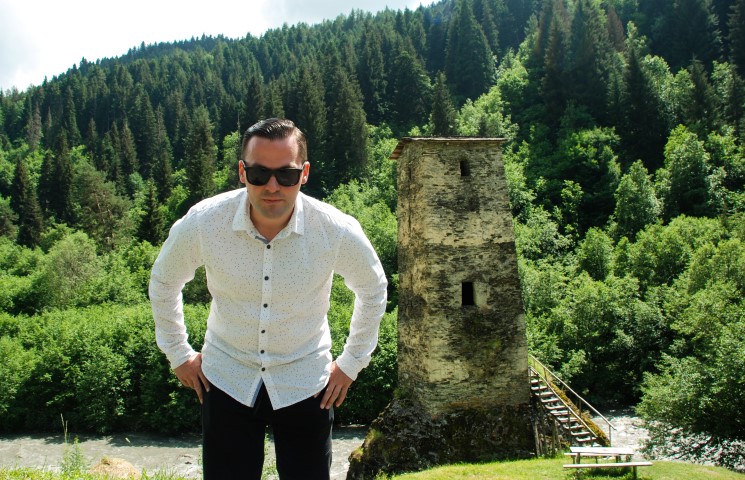
I once again pack my things and set off for Svaneti with a group of globetrotters – to Mestia, and then the upper reaches of the Caucasus, to the famed set of highland villages known as Ushguli, once upon a time thought to be the highest in the whole of Europe. The road from Mestia to Ushguli is now in very fine fettle, and we can cover the whole of its 50km length in a flash. Part of the road is muddy, then there is the picturesque Ughviri pass with its 12 metre tall precipice over a river bed. This is the most dangerous part of it, but the rest of the route, apart from a short section currently being repaired, is covered in asphalt now and easy to drive along.
The Girl from the Tower of Love
The other side of the most hair-raising bends, about half-way along the Mestia-Ushguli route, we stop by the Tower of Love. It stands alone on a giant rock, covered in grass and moss, drenched by the crystal clear waters of River Inguri. Most of the rock towers so typical of Svanetia tend to huddle together in groups – this particular tower stands all alone.
Legend has it that the rock which rests beneath the Tower of Love was the meeting place for a couple of local lovers. They came from different villages – one day, not long after they’d met, the lad set off on a hunt (another version of this legend suggests he went off to fight in a war) and died. The girl refused to believe the news of his death. She swore never to marry another and to wait for her beloved to return. For years, each and every day, she looked out for his return from their very own rock – without success. Finally, the family took pity upon her and built the tower in which she could take shelter from the surrounding elements.

This charming and yet heartrending tale reminds me of similar Slavic fables, such as the legend of the Love Mill, in which a girl falls unhappily in love with the Ghost of the Mountains of Krakonosze. Just like this mill from the highest range of the Polish Sudeten mountains, the Tower of Love in Svaneti attracts its own fair share of tourists. For 1 Lari, one can walk up a set of wooden stairs to see the beautiful views stretching all around its windows.
An Ill-boding Icon
It seems that the air in Svanetia is completely saturated with legends. They wait in lush green nooks and crannies, leaping out at us as if a warning from behind rocks, carrying promises across flowering meadows. The higher and further we go into the wilds of the Caucasus, the more we become caught up in its web of charms which begin to dominate the lives of Svanetian highlanders and visiting thrill seekers.
A little further along the trail to Ushguli, in a village called Kali, we find the orthodox chapel dedicated to St. Kvirike. Another interesting Svanetian legend is associated with this place. It concerns the king of the Imeretia region, who ordered a hundred Svans to come over and harvest the local fields. Only three of them arrived, but they did a fine job of carrying out the king’s demand. Pleased with their work, the king asked what they wanted to receive in return for their efforts – they only asked for one thing: a beautiful religious icon studded with precious stones. As they were returning home, they were ambushed and murdered by a band of robbers who stole their precious bounty. Soon after, each and every bandit met with terrible misfortune. The last remaining thief returned to Svanetia, begging for mercy and replacing the icon in the nearest chapel. Even so, he too met a terrible end – the Caucasus highlands do not forgive mistakes.
We then carefully drive a 4×4 jeep to a height of 2000 metres above sea level, surrounded by nothing save ageless green woods towering over the brisk waters of the Enguri, humming waterfalls and alpine dales. Here and there, we spot white fluffy sheep and brown horses racing across the distance, while the skies are scraped by the peaks of the Great Caucasus wrapped in dreamy mists. Looking around once and then twice, one might have the impression we have found ourselves in the Swiss Alps! The perspective changes when in the distance we see the wavering forms of characteristic, stone buildings.
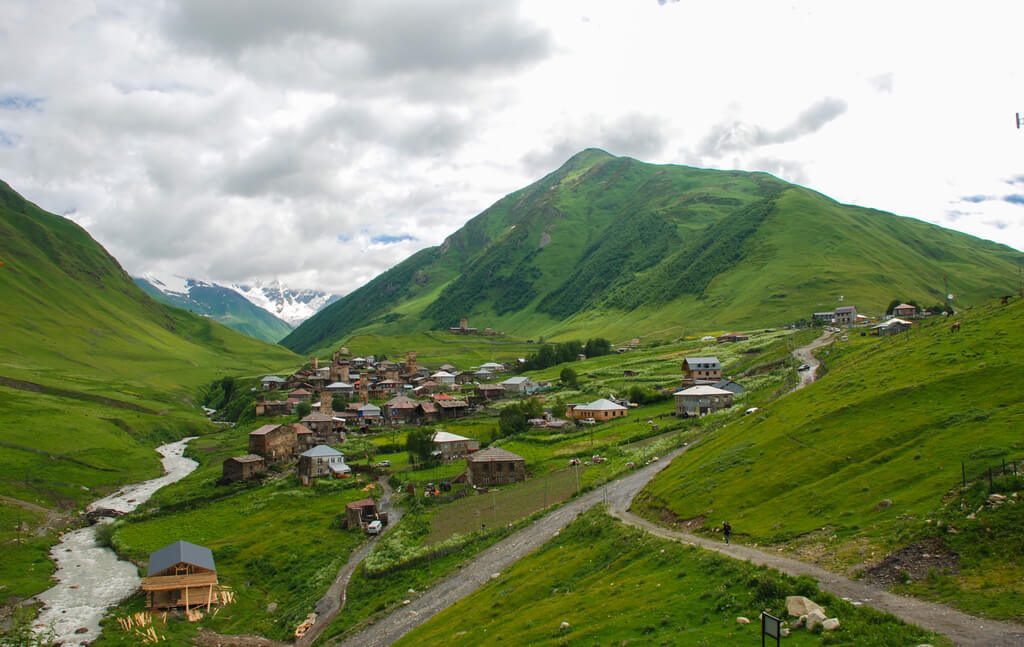
Not the highest and not just the one
Ushguli is said to be the highest village in Europe – and yet it is not a single village, nor is it the highest; in addition, the geographical borders of Europe are also disputable. In actual fact, Ushguli is a collection of four villages: Chadzashi (ჩაჟაში), Zhibiani (ჟიბიანი), Chubiani (ჩვიბიანი) and Murkmeli (მურყმელი). According to some sources, there is a fifth village – Lamjurishi (ლამჯურიში). All these settlements function under a shared name and occupy a location at a height of 2100 m ASL (some of these are found between 2060 and 2200 m ASL). It is not hard to notice that one can find villages which are set higher in Tushetia (the village of Bochorna – 2345 m ASL), which is also true of Dagestan. And yet, the “highest in Europe” myths which surround Ushguli tend to draw globetrotters to visit anyway – and rightly so, for this place really is worth seeing, hence its placement on the UNESCO World Heritage List in both Cultural and Natural categories.
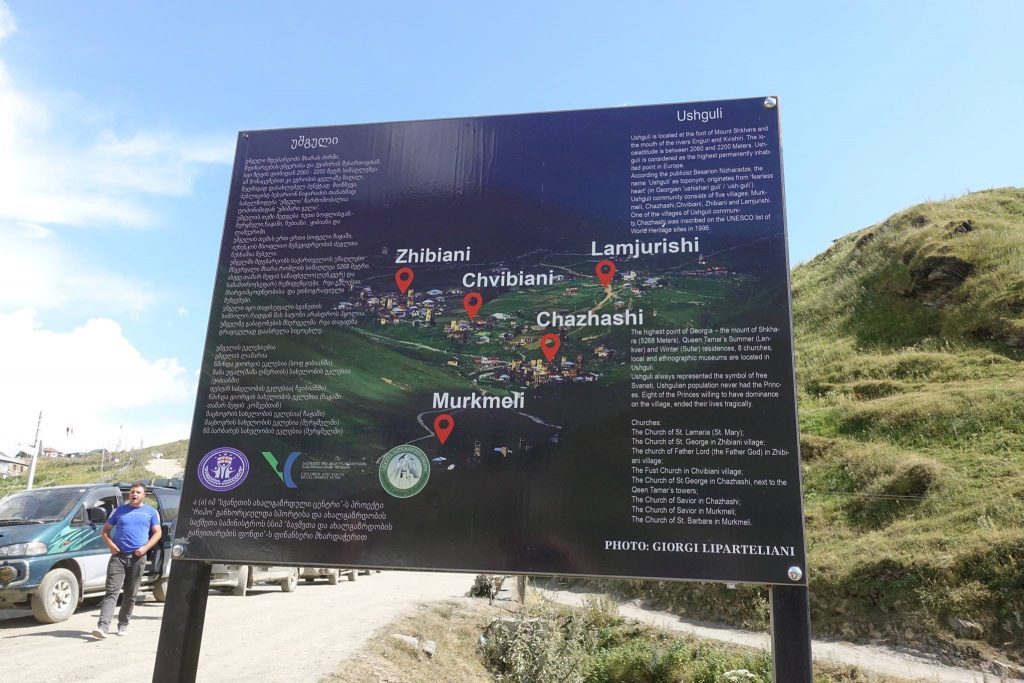
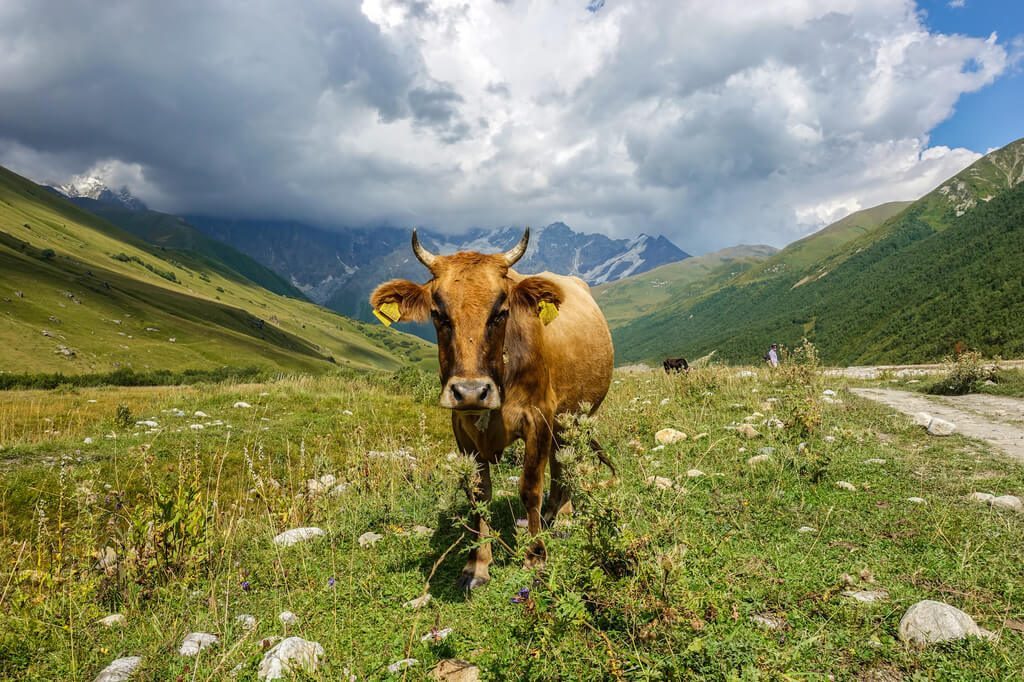
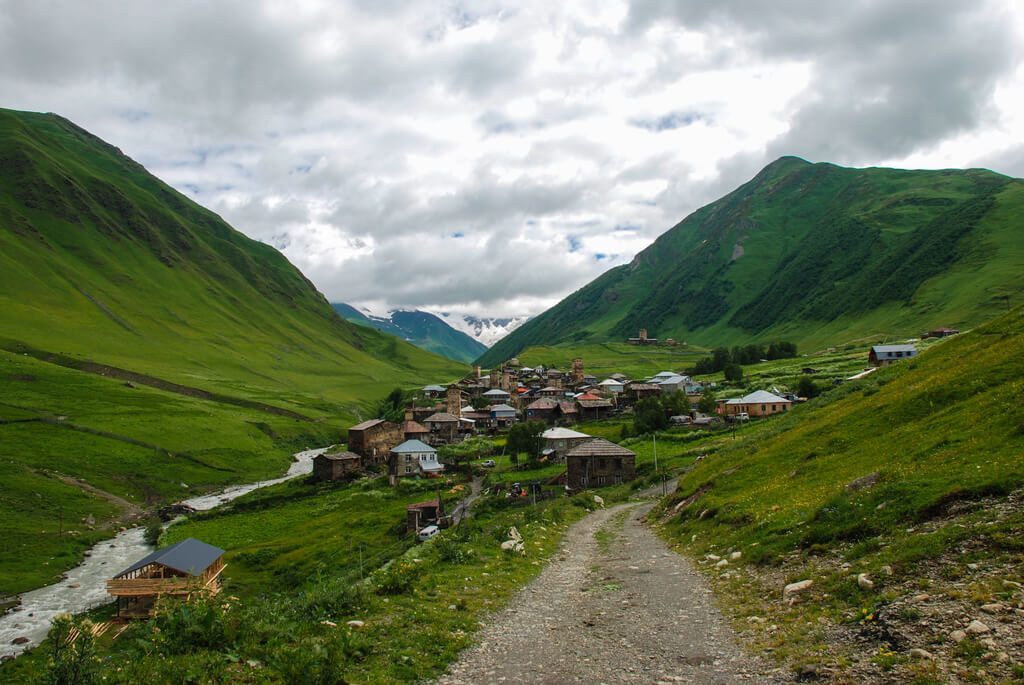
Before we venture deeper into the labyrinth of narrow lanes and houses made of stone, we will pass the nearby ruins of Queen Tamar Castle and pause in Cafe Koshki – a charming establishment with a solid rock floor, wooden walls, tables, chairs and bar, as well as a hand-carved Svanetian chair made for the machvishi – the head of the family. The name of this place, Koshki, is Georgian for “tower”, even though the building itself has (apart from its rocky walls) little in common with towers. Its garden does however offer astounding views of Shkhara, the highest peak in Georgia (5193m ASL).
We can clearly feel an advance taste of what Ushguli has on offer for us. But for the time being, it is time for us to stretch our legs, breathe in some fresh air and smoke a cigarette. People are winding down after a rather exciting ride here. I am not surprised. I will never personally forget the first time I came to this hard to access, and yet ever so magical place. I am pleased there are now more of us here, and that those who have read Georgian Wilderness and Georgia with Svaneti can also discover for themselves this remarkable part of the Caucasus.
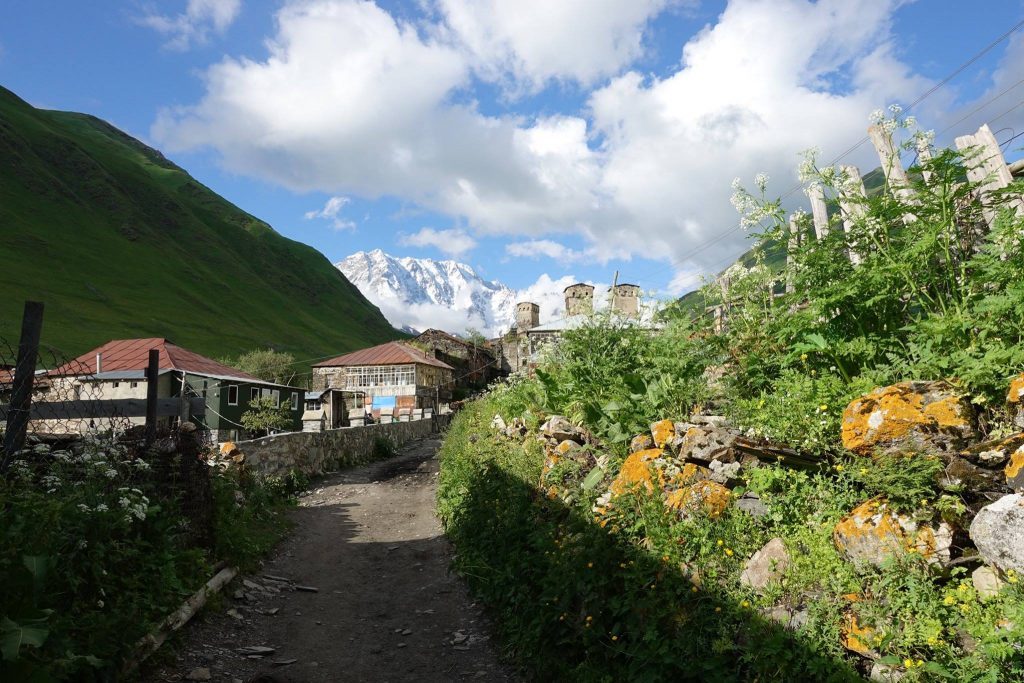
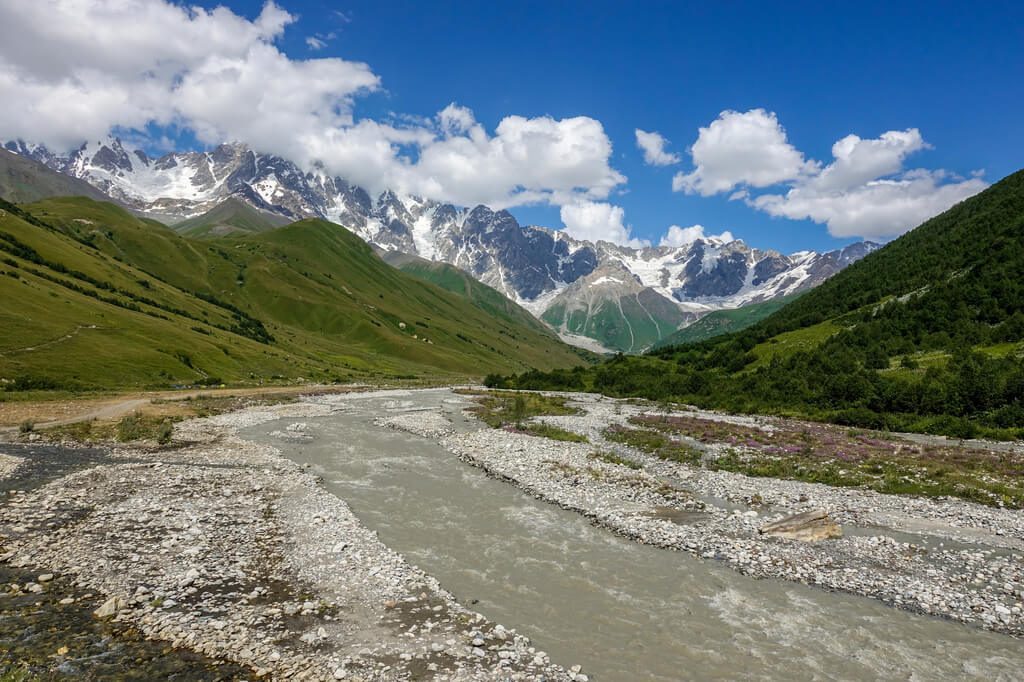
Pitchforks against priests
We circle the settlement, almost as far as the last house, where we come across a fascinating orthodox chapel called Lamaria, decorated with vintage frescos. A long time ago, this was the home of a pre-christian cult, then one of their pagan goddesses was re-christened as the Virgin Mary – and thus Christianity came to be absorbed by the local religion. Temraz Nizharadze, brother of renowned Fridon (someone we will look in on shortly) said that the monks sent here to spread the gospel did not initially click with the local population. They had a great big dog, which terrified everyone. There were other problems, with water and climate, which only made already poor relations worse. The residents of Ushguli had enough, wanting to gather together and attack their priests with pitchforks.
The Svans always had to work hard to protect their own community, and so their valiant attitude is no surprise. Temraz remembers very well the protests of the 1980s. The folks of Ushguli travelled as far as Tbilisi, for the government was not at all bothered by their appeals for help. They went on strike, because they finally wanted decent roads to be constructed in Svaneti, for water supply pipelines to be constructed, for an electricity grid to be erected, all in order to improve their quality of life. Which, at the time, was lacking in all aspects. Their loud demands for assistance were eventually heard, but this took decades of efforts. There is still some 15 kilometres of road to be completed leading to Ushguli. Which may not sound like much, but the Svans have been fighting to have this road completed for 30 years now! Which was not the end of their demands. Their native lands are home to over 200 medieval fortified towers – these rock symbols of the region’s past are found on private family plots of land, while also being part of the nation’s grand heritage. The Svans are desperately keen to have this heritage properly looked after – restored and saved from ruin.
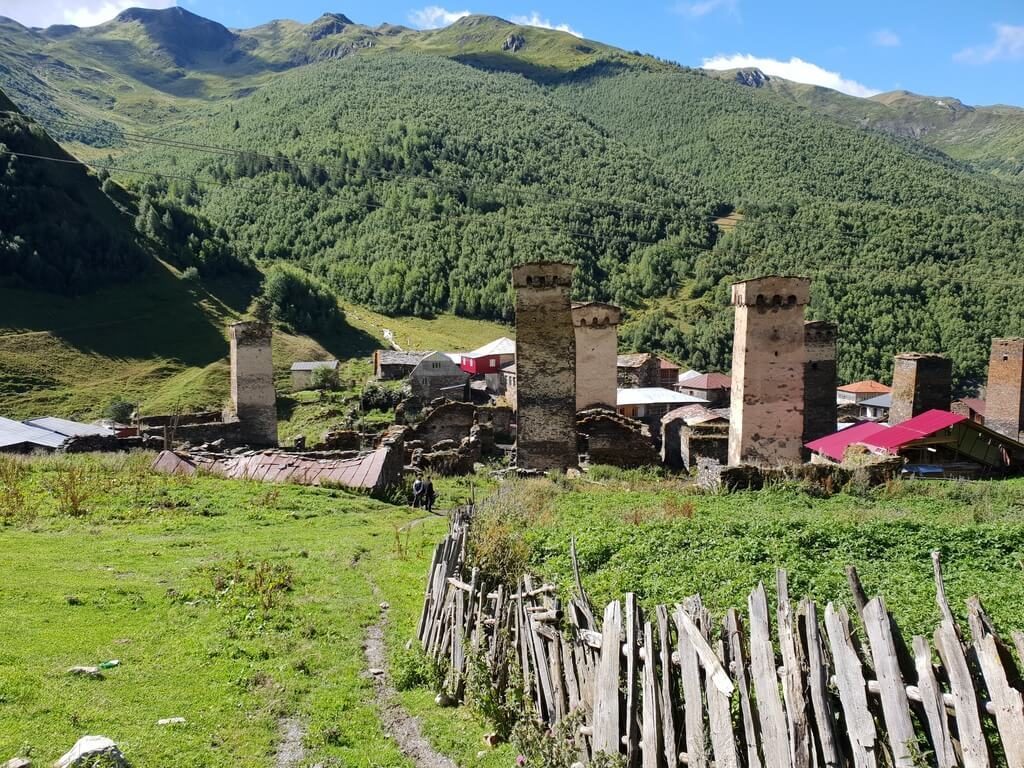
The issue of the towers and their plight is most urgent. On the 12th of August 2019, the Georgian film director Mariam Khatchvani once again reported about angry and despairing locals blocking the road to Ushguli, after a tower, dating back to the 8th century, collapsed due to disrepair.
90% of the towers in Ushguli are in urgent need of restoration, a problem made even more urgent by the coming winter, which further damages their already vulnerable structures. These treasures of centuries past, of which we are most proud (…) are dying right before our eyes. I cry and suffer whenever I see another tower and machubi cracked, for these are the artefacts of my childhood and an integral part of our collective past…” Khatchvani wrote on Facebook, desperately calling for urgent aid to be delivered to these objects of Svanetian heritage.
The post has been shared over 2000 times since, the discussion around it truly buzzing. Questions are being asked about what help is needed, along with offers of assistance, and challenges to the government and its failures in this respect.
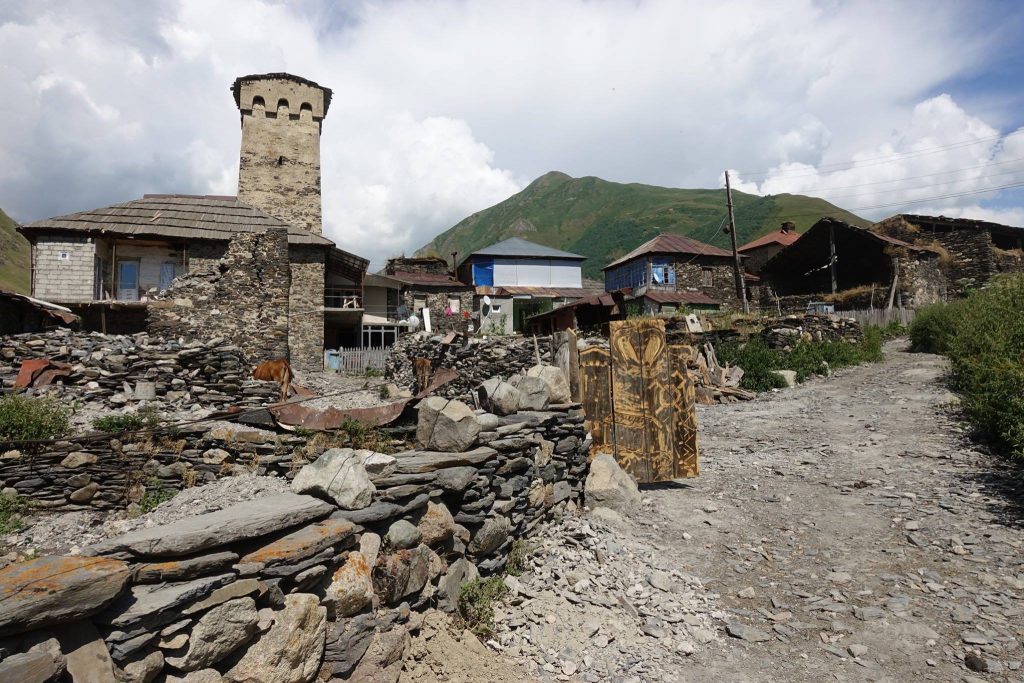
Khatchvani’s voice, added to that of the people of Svaneti, is being heard loud and clear, but may not be enough. Although it calls out all across the Caucasian highlands, it does not seem to be reaching the ears of those who should decidedly hear and take action. People are truly angered by the fact that the government gives so little to help upkeep the towers, and what little it does give makes little or no difference. Bidzina Ivanishvili, Georgia’s wealthiest businessman and philanthropist, donated some 3 million lari (in excess of $1,000,000) to the cause of restoring the towers, but there is no sign of any work being carried out as a result. People are, therefore, protesting still. The reasons for their engagement are twofold – first of all, the weakened structures cause a risk to the public: residents and tourists. Until they are restored, they are ticking time bombs presenting a constant risk to life and limb. Secondly, the towers are a treasured element of local architecture and ancient traditions, which must at all cost be maintained and preserved for future generations.

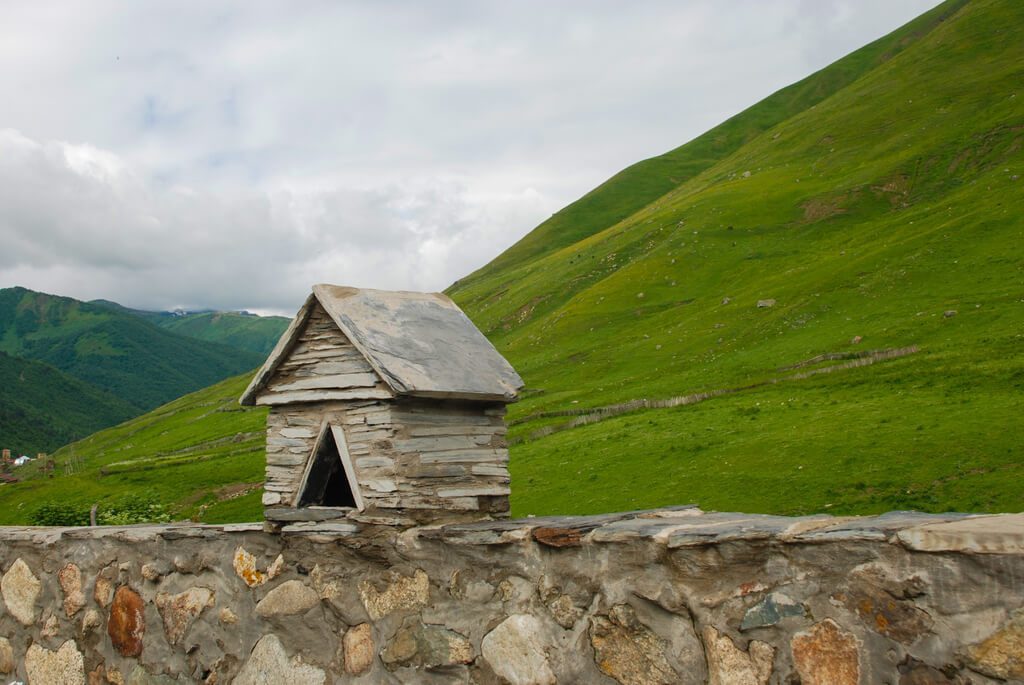
Svanetian salt a grain of grief
Those who do not know any better, might be surprised at how every day life in Svaneti can be a struggle – yes, the landscapes are truly stunning and the idea of living so far from the hubbub of modernity may seem idyllic at first – yet each and every day presents its own new challenges. Many residents of Ushguli and other villages in the area live a life of real hardship, very much far from fairytale ideals. The reality of life here is that the people of Svaneti very much need assistance from their government, as well as direct aid from generous souls who will help them care for and protect their architecture, history and culture from further erosion and forgetting.
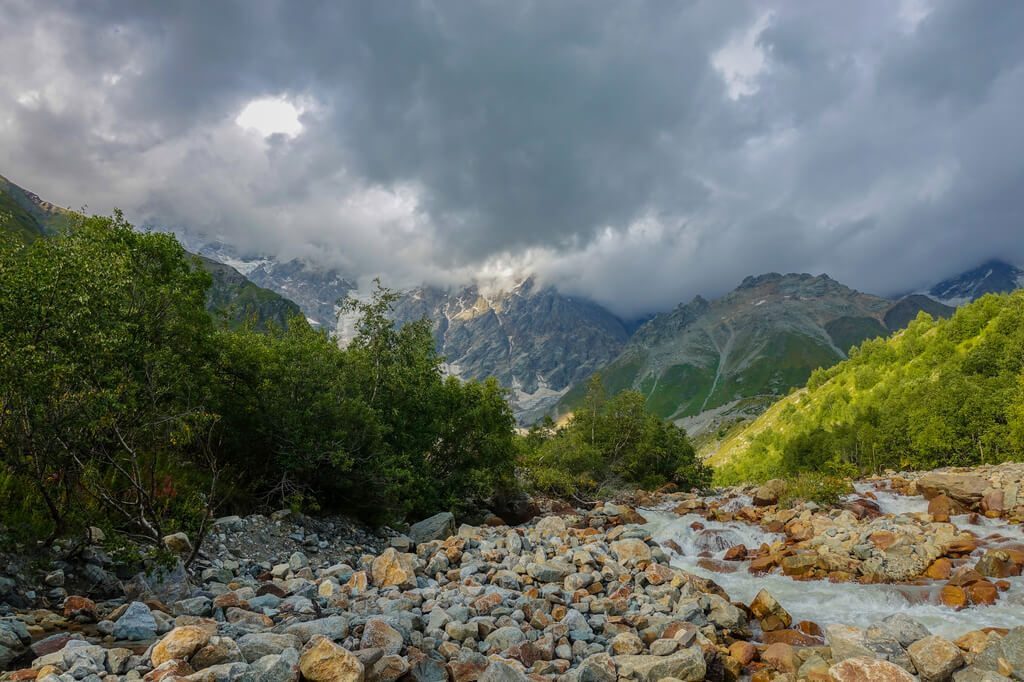
What matters most to them is that any attempts to preserve items of local heritage are conducted in line with custom and tradition – not like the five-year modernisation plan imposed upon the region by Soviet Russia in 1928-1932. The idea was that “backward” Svaneti would become a model calling card for Soviet-style progress. Industrial centres were constructed, along with airfields and roads – especially the one used to transport Svanetian salt, one of the region’s most prised natural resources (as well as being a very popular tourist souvenir). Soviet authorities also tried to alter the way the Svans had lived in for centuries, something which proved much less popular with the locals.
The wonderful film Salt For Svaneti (1930) documents the everyday lives of the residents of Ushguli – its director Mikhail Kalatozov was to shoot a feature length film celebrating propaganda-style the Bolshevik ideals of how the distant regions of the Caucasus were being modernised. And yet this sensitive artist managed to capture the unique folklore and lifestyle of the Svans, exploring and describing it with his cameras, images interspersed with perfunctory title screens. As a result, he created one of the first ethnographic films which, right after its premiere, became a real “grain of salt” in the eyes of the Soviet authorities. Kalatozov fell out of favour, becoming heavily criticised and denied further opportunities to make movies.
Although the authenticity of many scenes in Salt For Svaneti was questioned by Ushguli residents, the film allows us to discover the secrets of local customs and better understand why Svans are so keen to protect their cultural identity.
Nature, towers, people
In protecting their little homeland, the Svans have been staunchly rejecting modernity in all its most advanced forms. Apart from purely financial reasons, the houses in Ushguli are not an impressive sight, being rock dwellings erected hundreds of years and over time enhanced with some very basic tools and methods. Right next to them, huts and garages made of rusting metal have been added, surrounded by rickety fences made of wooden planks. Washing lines are stretched between houses, and walking among them one has to be careful not to trip on rocky paths or dogs running round freely. Then there are the sleepy cows which wander round town, adding to the natural charms which surround Ushguli – a truly remarkable set of sights, high up in the mountains, accentuated by charming 12th century towers and local folks. And it is the former which the latter are so keen to protect and preserve – the towers are a proud testament to their fighting spirit, something the Svans have been renowned for since time immemorial.
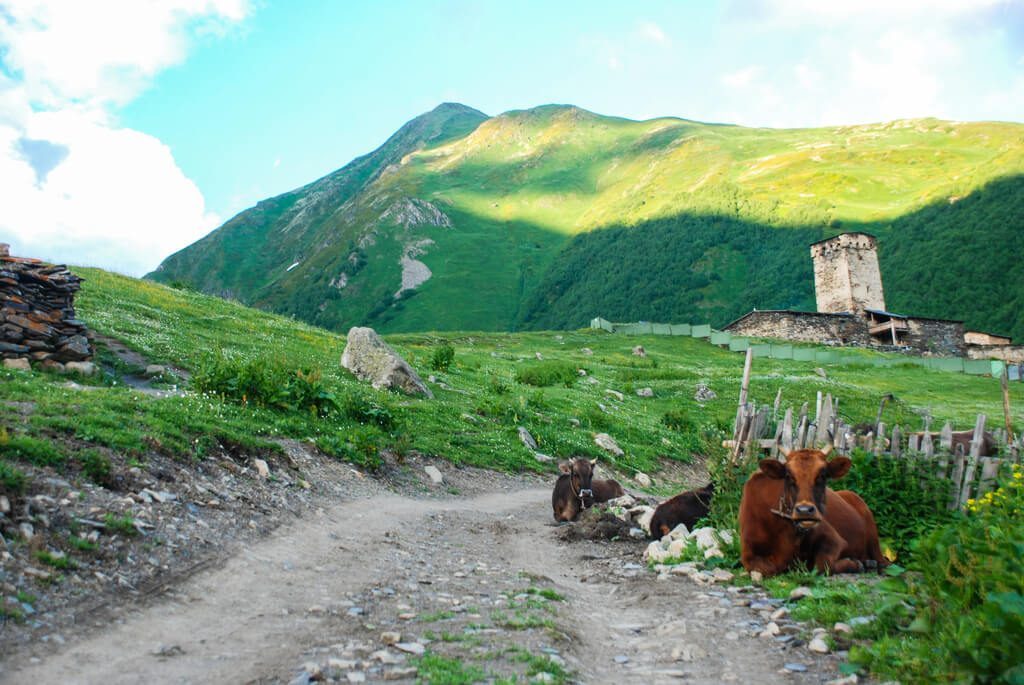
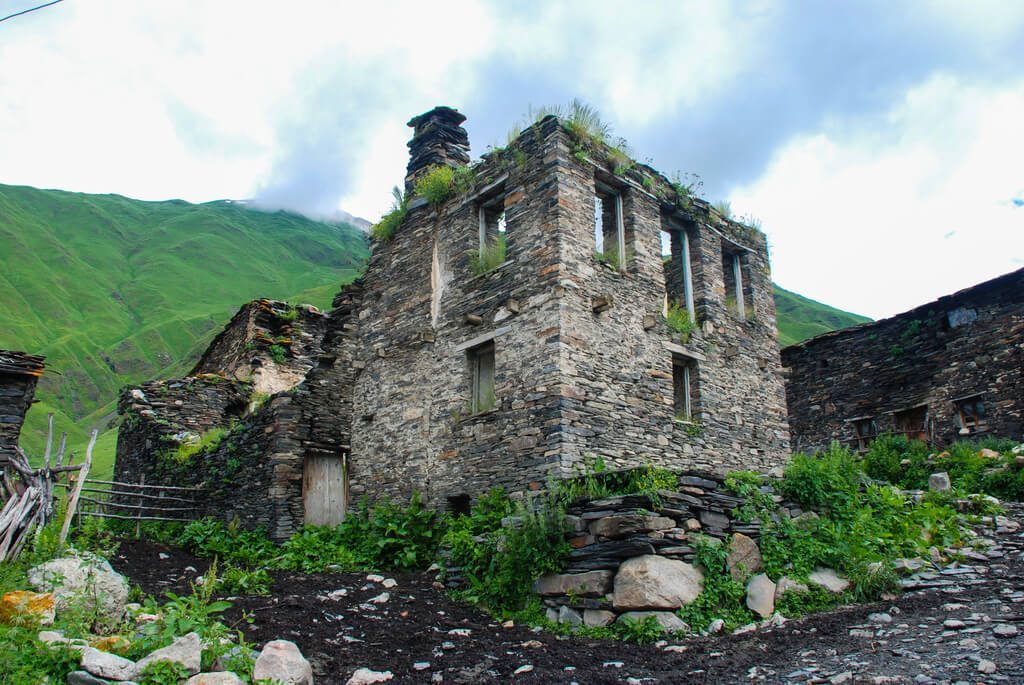
Talking to the locals, one often hears them proudly state that they have always been free highlanders who have never been subjugated by any foe or invader. All the problems and disputes encountered along the way were always resolved internally, debates held when people gathered round one of the 40 or so towers in the region. These rock fortresses, rising tall above the meadows and town roofs, protected Ushguli from invading forces, as well as from violent blood feuds, involving clans throwing themselves at each others’ throats. They also helped people survive vicious avalanches and snow storms, some covering the region up to 12 metres of snow! It is therefore not surprising that to this day the streets and hostels in Ushguli are full only in the summer months – come winter, life here dies down, for massive snow piles block the road to Mestia for 6-7 months per year, essentially cutting the village off from the outside world. The most fierce winter cataclysm hit here in 1987, when a snow avalanche literally swept away half the buildings in Ushguli.
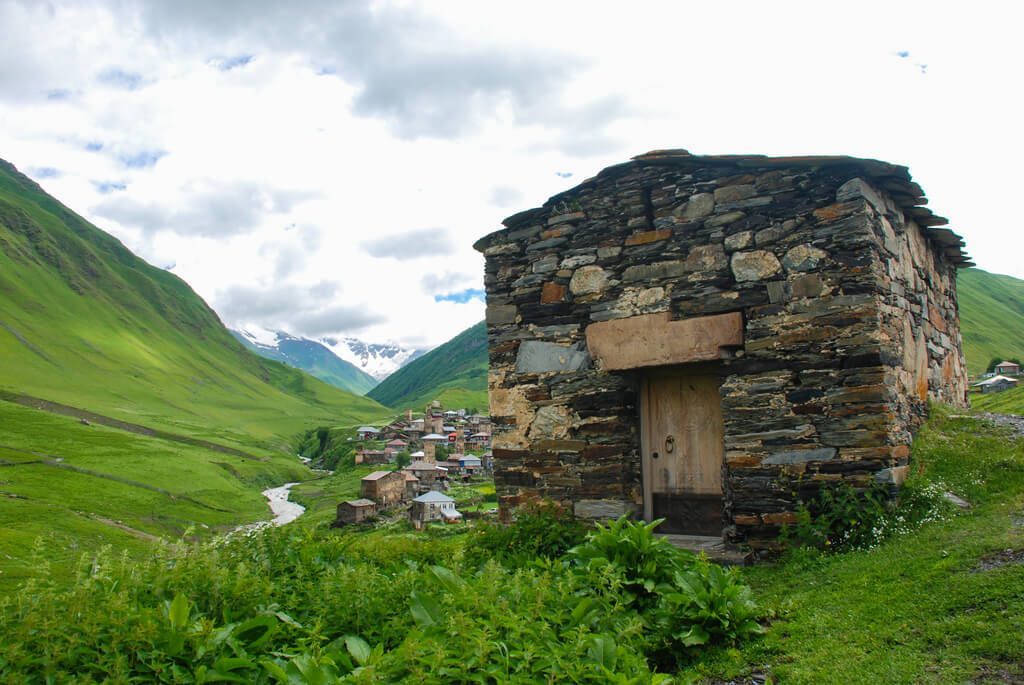
Guardians of Svan heritage
Ushguli is home to some 270 people, not all of whom reside there in the winter. Many move away during the months when the ice and snow are at their meanest, returning once everything has thawed in the summer seasons. They are then followed by tourists, travellers and those keen to discover unknown parts of our world.
Ever since budget airlines started flying to Kutaisi, Svaneti has become the first destination and stopping point for those wishing to discover the sights and flavours of Georgia. Visitors stay for a day or two – convinced they now know what life here is like – then move on, often writing articles and screening films which purport to say what life here is really like. But in order to get close to the essence and magic of this region, one must spend more time here – in order to really touch Svaneti with all our senses. To my mind, this is still too little: outsiders will never truly be able to grasp and understand the essential nature of Svaneti.
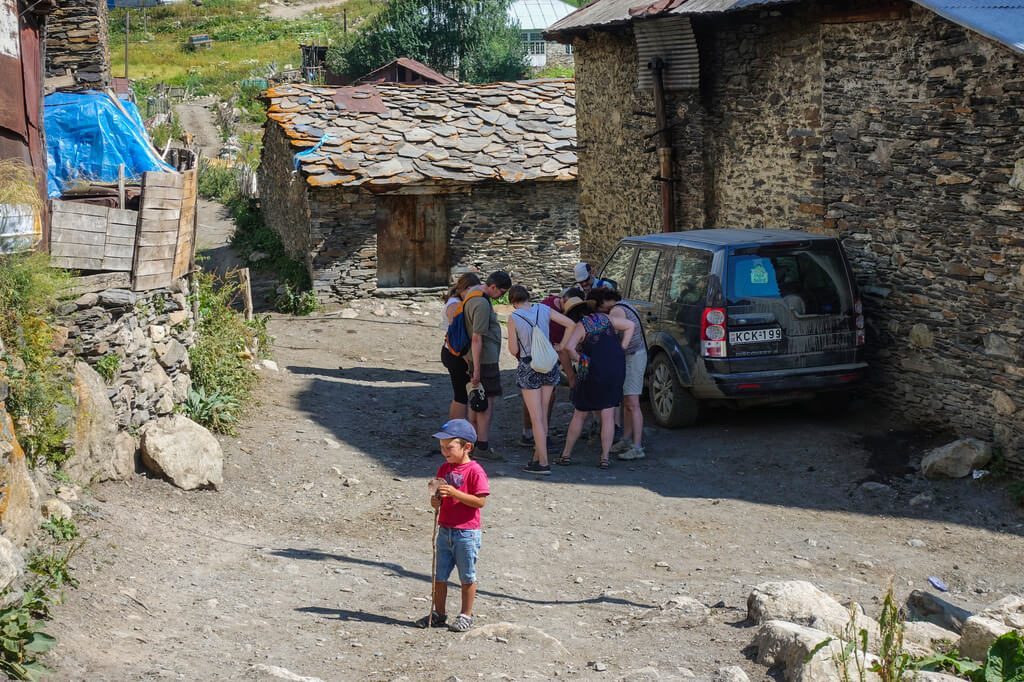
It is not possible to instantly grasp why these folks are still struggling to live here, a place where no human being can stand up to and win against the full force of our natural world. Young people tend to leave Ushguli, but this is not always the case. Here they are surrounded with their nearest and dearest, parents and grandparents who also need to be helped run their farms, as well as their hostels and restaurants. Temraz’s daughter, Mariam, lives in Tbilisi. Her son, Mamuka, does so too. I missed her by just a single day, as Temraz had driven her to the capital via Mestia, where a mashrutka bus service continues the journey (12 hours in total). Each trip to or from Svaneti is a whole day taken up travelling, but people have lived here for centuries, and live on there they shall.
For Svaneti is a unique blend of culture and history, which must be protected from being forgotten. The residents of Ushguli stand guard over their traditions, which allow them to survive, their roots holding firm, resisting the call of more comfortable, easier lives elsewhere in the world.
Ethnographic gems
In order to better understand the residents of Ushguli and their efforts to maintain local heritage we must travel to meet and talk to them at length, to listen and learn. We can also see movies, such as the drama Dede (Grandpa) released in 2017. Directed by Mariam Khatchvani, it focuses on the life of a young woman called Dina, whose hand has been promised to David by Dina’s grandfather. Yet her fiancee returns from a war with a handsome friend called Gegi, and Dina rapidly falls in love with the “wrong man”. Will she now be able to resist the obligation to honour decisions made for her according to local traditions? The film is not just about love – it is above all a subtly artistic presentation of Svan customs, traditions, rules, beliefs and interpersonal relations, which in this isolated highland region have been cultivated for millennia and seem beyond any one person’s power to alter.

In order to truly understand Svaneti, we really must visit local heritage sites and museums. In the village of Zhibani, one can go inside a machubi, which is a traditional homestead where people used to once upon a time live together with their livestock. On display are everyday tools and utensils, as well as icons and carved doors dating back to the 11th century. Zhibani is also home to an orthodox chapel, filled with sacred silence, its rock walls decorated with original icons illuminated by candles lit by the local faithful. The village of Chadashi is similarly religious in its character, its museum offering displays of sacred items from seven nearby churches – mostly silver and gold icons, as well as crosses from the 12th and even the 6th century.
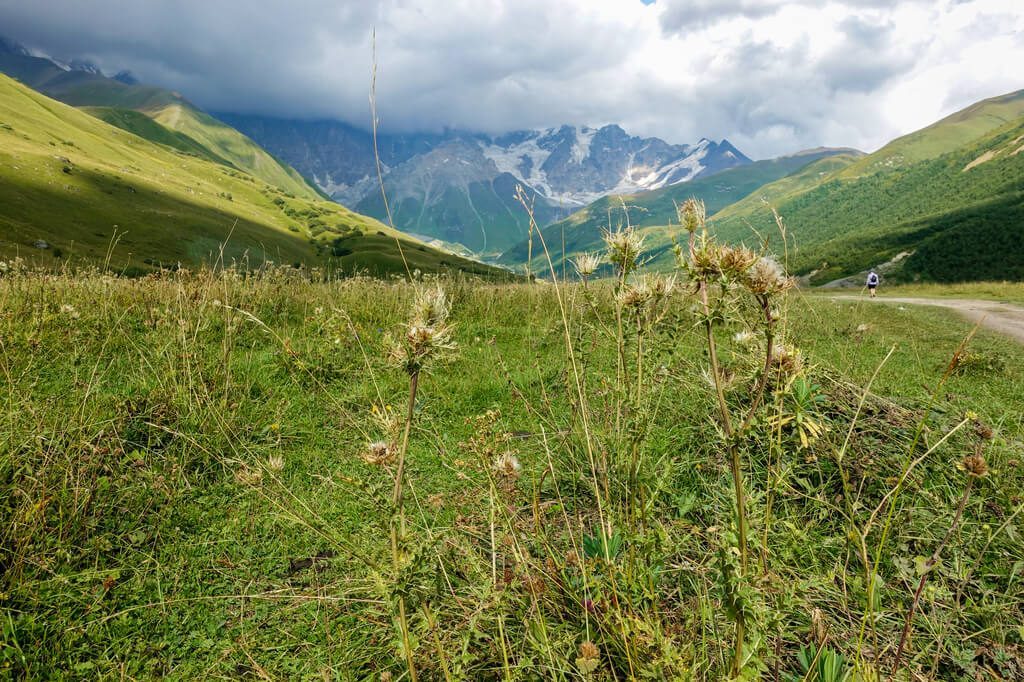
The most interesting thing in all of Ushguli however is the ethnographic museum, situated in a 13th century stone-walled tower. Its collections, set up in this unimposing building, allow us to literally immerse ourselves in Svaneti culture and life lived by the hardy highlanders. It contains many items used in the past for cooking, cleaning, childrearing and farm work. The museum also offers information and insight into the structure and purpose of the local rock-walled architecture.
Music where the ages cross paths
This time, the Ushguli ethnographic museum offers us the chance to experience something more. I chat with Gibo, a young man who runs the museum, and ask for his aunt to play for us a set of traditional Svanetian songs. Even a year back, such concerts could be arranged for those wishing to listen: entry to the museum costs 5 lari, while arranging a concert – 20 lari on top of that. Alas, it turns out the ageing artist no longer visits the museum nor plays for tourists – yet, for us, she agrees to make an exception.
Gano Charqseliani is a slight old lady with a delicately wrinkled face. Her eyes are large and glisten with slightly shy curiosity. She gives the impression of being delicate, but as soon as she sits on a carved wood chair and picks up a traditional instrument called chuniri, she is surrounded by an aura of immense energy, unlimited power and great grace so characteristic of the Svans we find here today. The very first chords, lively and forceful, give the moment a unique beauty – my eyes fill with tears, yet I still grab my camera and record this utterly unrepeatable performance, sensing I am capturing for posterity something of a priceless yet fleeting past. One which could dissolve at any moment like a mist, as soon as this wonderful artist once more rises from her wooden chair, perhaps never to return to it again.
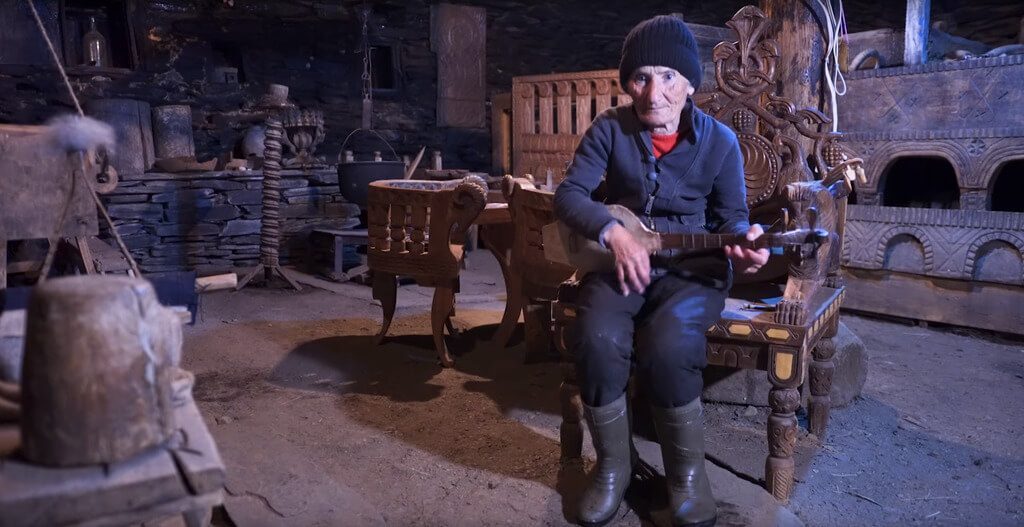
Cultures fade along with the people who created them. In a dozen years or so, the sounds of Svaneti can be forgotten, no one bothered by the life lived here, everyone focused on the big wide world of the West and its busy ongoings. Yet, these towers, these majestic, mythical mountains will last for ages yet. Along with them – legends of Jason and his journey to claim the golden fleece, or the fables of Strabon, who described the Svaneti tribes in these regions. This famed Greek geographer, historian and traveller, having first wandered into these largely inaccessible regions of the Caucasus, noted how many things connected the Svans with the ancient Sumerians. The legends told by the Svan ethnic group – one could call them a separate nation all of their own – to this very day maintain ancient Sumer traditions, traces and artefacts. The Svani dialect, an early version of modern Georgian, contains many Sumerian phrases and inflections (according to most linguists, the Svani dialect, much like other Kartveli languages, should be classified as separate tongues in their own right – the lack of such status being assigned to them leads to the gradual erosion of this unique form of speech). This may be why – much like the ambitious, mighty and courageous Sumerian rulers – the Scans have for centuries been so valorous, fearless and indefatigable. Strabon often mentioned in his tales the hardy highlanders of these regions, capable of fronting armies up to 200,000 warriors strong, who would welcome enemies with hails of poison-tipped arrows. Their bows over the ages were swapped for huge rifles – and not without good reason.
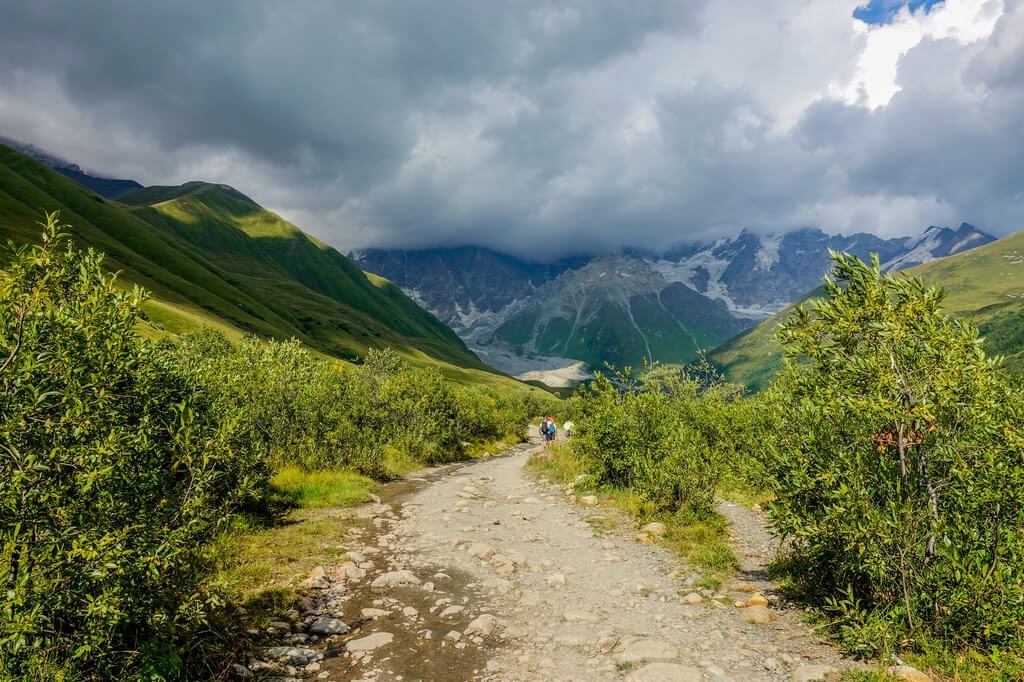
The secret of the burning root
Svaneti managed to hold invaders off for a remarkably long time – finally surrendering to the mighty forces of Tsarist Russia, but it didn’t go down without a noble fight. Lands in the east of Georgia, Kartlia and Kakhetia, were absorbed into the Russian Empire in 1801, but those to the West, including Imereti, not until 1810. Alexander the 1st and his armies needed another 30 or so years (the fighting took place over 1803-1878), for those who had managed to cross over the imposing mountains then had to contend with the chivalrous highland defenders. It is therefore unsurprising that this region has historically been thought of as loaded with danger – it is worth recalling that as late as the 1990s, this region was known for the occasional crime of kidnapping.
Svaneti today is different, very touristy. Many of the folks here speak excellent English, attracting many visitors from all around the world, drawn by the bounties offered by nature, its unique culture and architecture. Some only come in order to meet Fridon – a famed local painter.
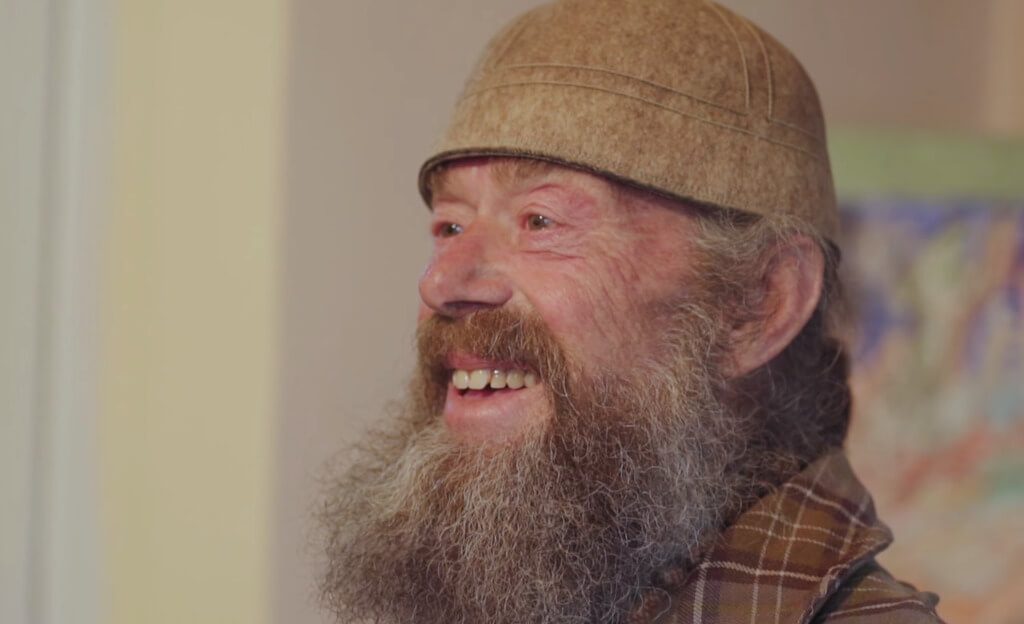
Fridon Nizharadze lives with his brother Temraz, who runs the pension house Gamarjoba with his wife and daughter. I always rent rooms here, keen to hear their stories, feeling right at home in their remarkable abode, where almost every available bit of wall space is covered with Fridon’t paintings. The air here is very homely, warm, time floating past in a pleasant atmosphere, aided by substantial amounts of fine wine and chacha. When I visited here in 2018, Temraz gave us samples of his special vodka, made using special ingredients which work wonders for… one’s root. His root engorged, the tourist complaining later. He suffered for a whole four days. Another time, as I was visiting, the local lads’ eyes were tellingly dim and somewhat smallish. It was clear they were suffering from nabachusewi – hangover. It turned out the night before the men were selecting pigs for castration, and so I joked that they got drunk in order to show solidarity with the males of a different sort of species.
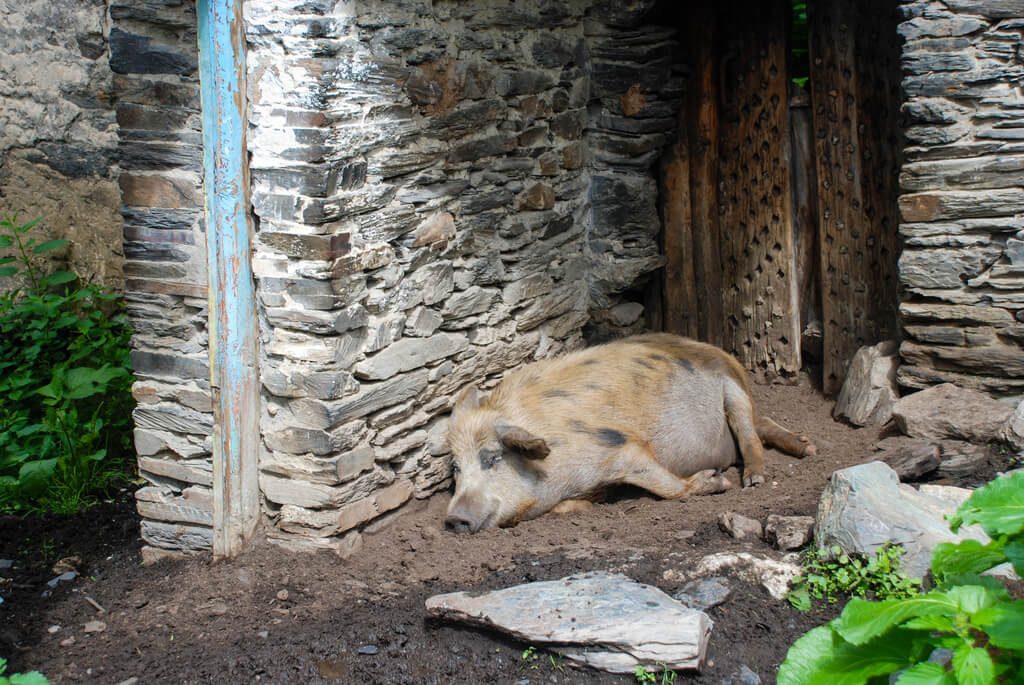
This time, we sat up late, sampling the wines I bought in Kutaisi’s winebar Sacnacheli. I had selected dry white cepas wine – made from a mix of two sorts of grapes: tsitska and tsolikauri. I do believe this is a really fine beverage – the choice is abundant, and each bottle costs more than 50 lari.
“Shop-bought you bring us!” Temraz said, affronted. I first poured him some tsitska tsolikauri, then just tsitska for comparison. “Magic! Very fine wines!” – he concluded, this time with admiration in his voice.
Any time Georgians tell you they like a wine, this really does mean it is worth drinking. In any case, I would never have given Temraz any old stuff to try. For years now, I have been learning all I could about the secrets of winemaking processes – and will soon enough open my own winery in Kakheti – my dream of so many years finally coming true! A dream which is truly special, considering Georgian winemaking traditions are unique in the world and protected by UNESCO patronage. A heritage I now wish to nurture and be a part of. Meanwhile, far from the lowlands of Kakheti, I spend a magical evening sipping cepas in the shade of the highest mountain in Georgia.
Spending the night with Fridon’s artworks
Time flows by lazily as we sit and chat, laughing and drinking. I show Temraz the film I shot in Ushguli two years back – a beautiful document of all that which we had experienced and delighted in here. Wine loosens our tongues, opens our hearts and we freely talk about our innermost thoughts and desires. This may in part be caused by the fact we are surrounded by paintings created by Fridon Nizharadze – a painter with a cult following in many specialist circles. This artist, painter, sculptor, philosopher, poet, visionary, pedagogue, self-appointed orthodox chaplain and outsider is in a word a truly unique character and Ushguli’s very own living legend.
Fridon – initially self-taught, eventually graduating from the Fine Arts Academy in Tbilisi – was born on the 24th of August 1944, and today is slim, long-haired, with a thick beard and deeply wrinkled face – a man with a truly extravagant air about him. He sees no limits to anything, perceiving life in absolute categories, including religious and social concepts. His talk can veer wildly between Svan culture and the president of the United States, to then instantly move to mention of World War Two.
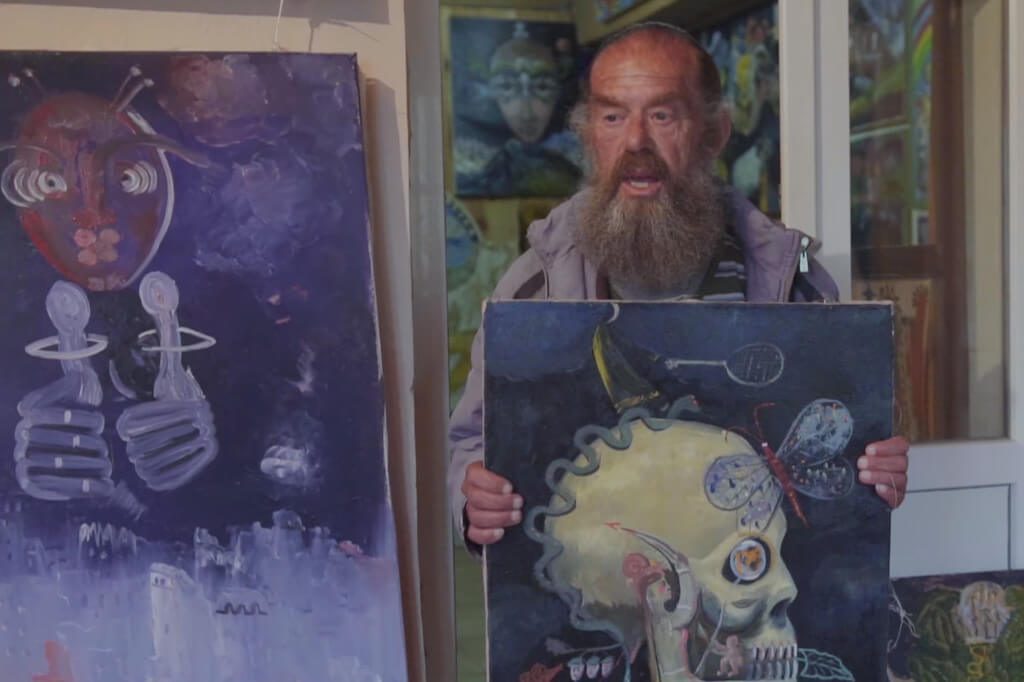
Fridon’s way of living and creating were unacceptable to the Soviet authorities which ruled here not that long ago. Georgia’s communist government, which Nizharadze openly disdained, quickly labelled him as an ordinary madman, deserving of psychiatric treatment. His family, frightened by this attack upon him, felt Fridon should use his talents in new ways and begin to paint ordinary things: the local fortified towers and highland landscapes. But Fridon always told them that he cannot stop the grotesque thoughts coming to his mind, ones he simply had to then pour onto his canvases. Nowadays, Nizharadze no longer has to suffer unfair attacks and criticisms, being a highly respected member of the local community. This too is its own form of artistry: the art of being there for others. When I say this out loud to those gathered round me, I can see their eyes starting to tear up.
Whenever I come here with groups of travellers and stay with the brothers Nizharadze, we start talking about the potential purchase of Fridon’s paintings. Yet, the artist is not to be talked round… he won’t let a single one of his canvases leave Ushguli. And if anyone tries to convince him – prices range at about $50,000 US dollars, which does not surprise me in the least. His works are true treasures, essential items of local heritage, which is a key part of the culture of Svanetia and Georgia as a whole. The artist would rather his whole collection, missing not one single artwork, remain in his home town, seeing as it is inherently connected and imbued with its unique character, its meaning lost when taken out of the geographical context. Reproductions of his works can be purchased instead, along with drawings made by his famous hand.

I look out the Nizharadze pension house windows, watching Ushguli at night. Its rock towers scrape the skies proudly, illuminated subtly by streetlights, silence falling over the town. It occurs to me that this really isn’t the sort of place one would expect to find a painter working in impressionist style. And yet here he is, cut off from civilisation like some sort of hermit, living without a mobile phone, sometimes without access to electricity and water. The mountain ash trees outside his front door commemorate the friends he lost in the skirmishes fought in 1989 – then there are his brushes, paints and canvases, upon which he used to create – for he hasn’t painted anything new for years. I can still see many of his colourful, psychedelic works, featuring wild, allegorical elements from Georgian mythologies, even as I lie back in bed, eyes closed, falling sound asleep within easy reach of Svanetian hills and mountains.
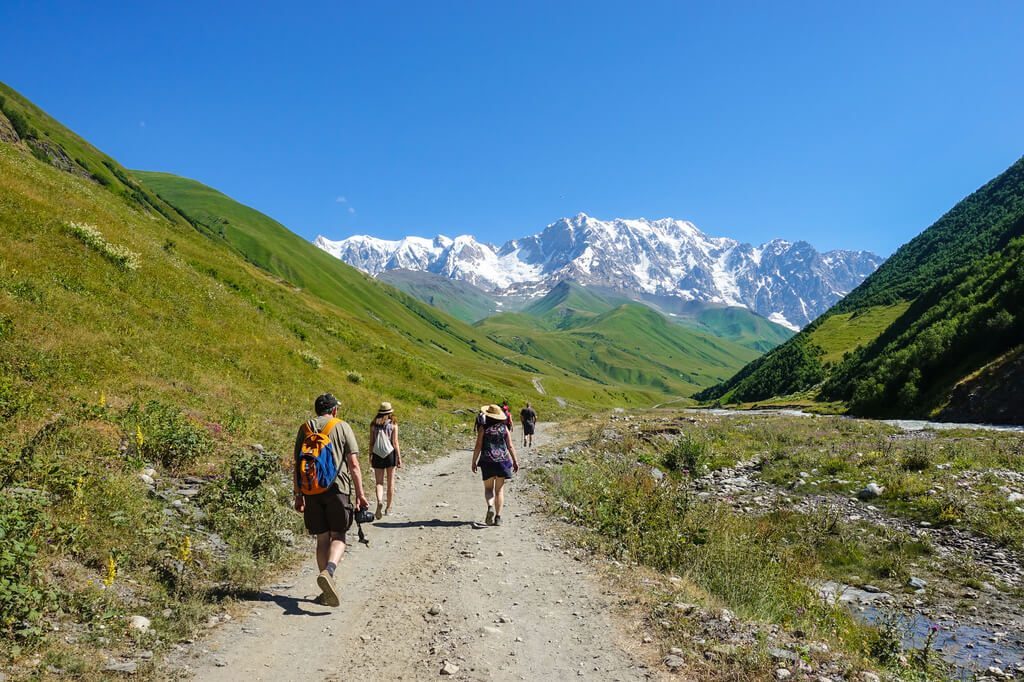
The breath of the Ice Queen
With every hour which passes this August day, the temperature in Ushguli gradually reaches 30 degrees Celsius, but dawn is blessedly refreshing. This layer of early morning cool is cracked with the aroma of freshly brewed coffee. Steaming cup in hand, I stare up at the final destination of today’s trek – the snow-covered might that is Shkhara, today once again coyly hiding in low hanging clouds, presenting us with a gently mystical climate…
During our 6km journey to the glacier which crowns Georgia’s peaks, the head becomes clear of thought, filled instead with feelings of delight at the unspoilt, wild views of the High Caucasus. The area is a lovely mix of gently sloping green hills and rocky mountain passes. Our horses dip their snouts in the raging waters of the Enguri river, the world around us almost exclusively green-blue-white, if it wasn’t for wild flowers sprinkled all over the surrounding meadows. Oh, to spend several days and nights in these harsh yet stunning regions, at the end – or beginning – of another Georgian world? That would be Svantastic!
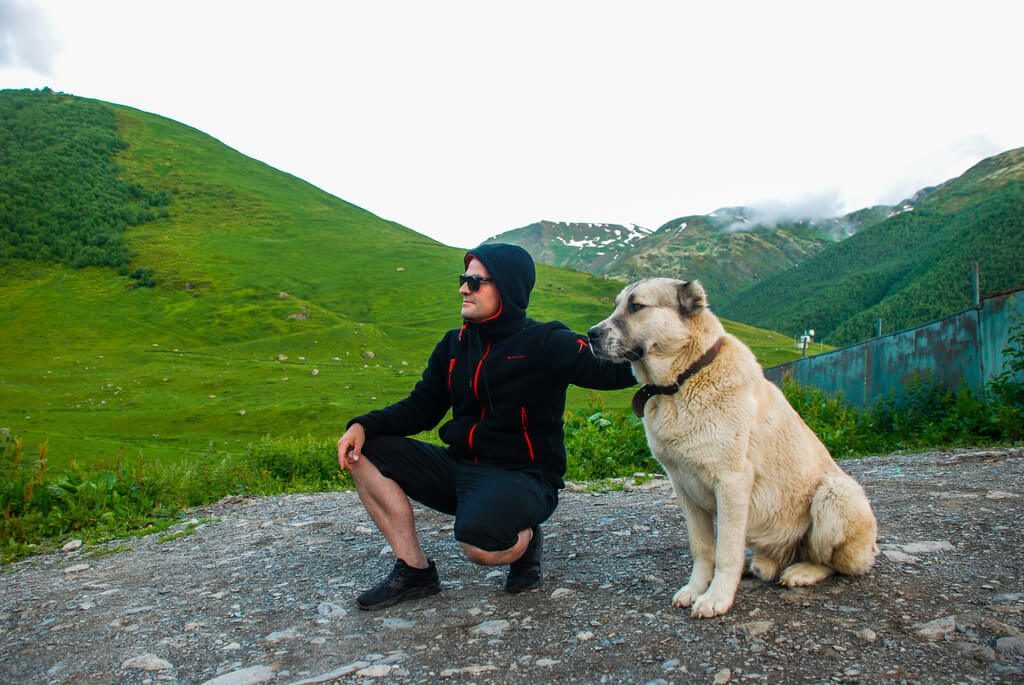
With each and every passing kilometre of gentle climbing our stomachs grow hollow – soon to be refilled at Shkhara Glacier Restaurant, open since 2019 in a charming little wooden hut. Before its opening, we would have been served by a temporary gastronomic tent. Beers are already cooling in the river, food and drink awaiting. We order a cucumber and tomato salad, a litre of compote, two coffees, one chachapuri and two beers. The price matches the size of Georgia’s tallest mountain nearby: 68 lari. We know why its so high and there is no need to complain. Balking at these relatively high prices – and I do hear groans from tourists – are pointless, and unjust, baseless. Considering how harsh life is up here, every day existence costing the locals plenty of pain and effort, every Lari is worth as much as a bar of gold. We pay extra, because we are now at 2390m above sea level – blessed to be able to sit and sip our beers face to face with the monumental glory that is Shkhara.
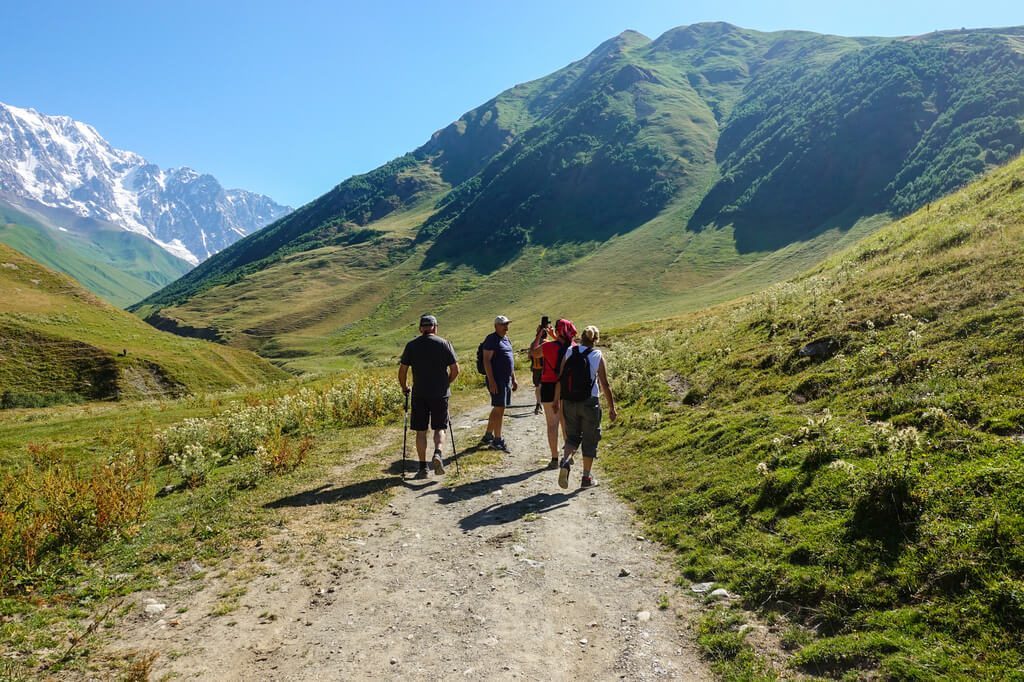
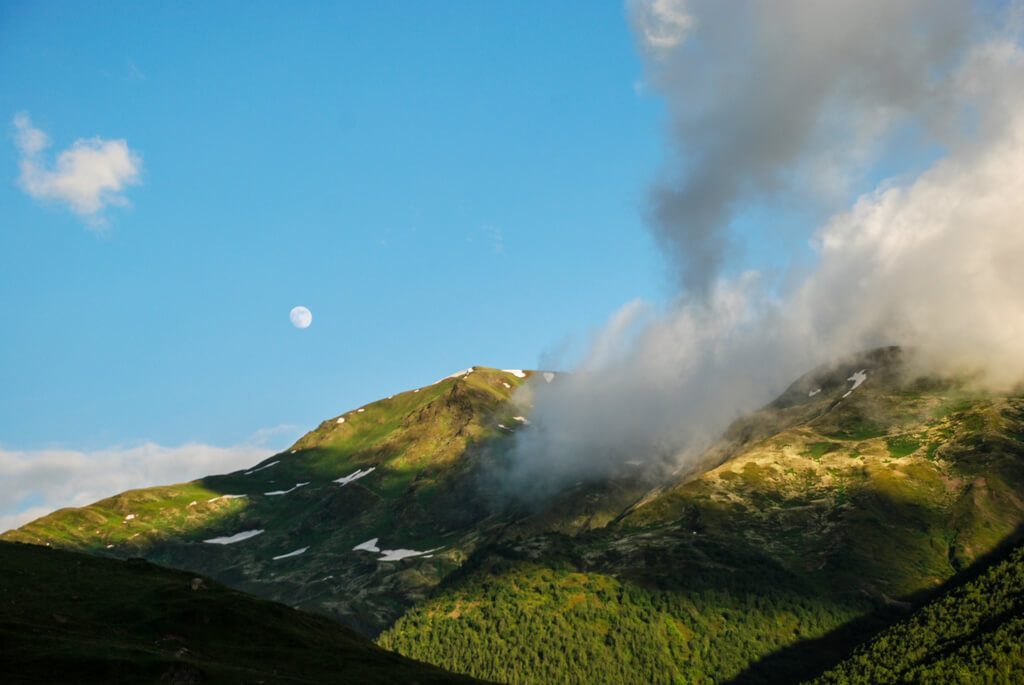
Visitors to Svaneti come here with a range of expectations, ideas and habits – this region, in turn, has its customs and laws, protected for millennia by the mountain ranges of the High Caucasus and some 800 defensive towers. Then there are the locals – adventurers, friends, visionaries, musicians, farmers, miracle workers – who will go to extraordinary lengths to preserve their traditions and native treasures. As a result, Svaneti remains a place where our experience of the world happens on a very different level of being, searching and discovering. A truly free and gracious environment.
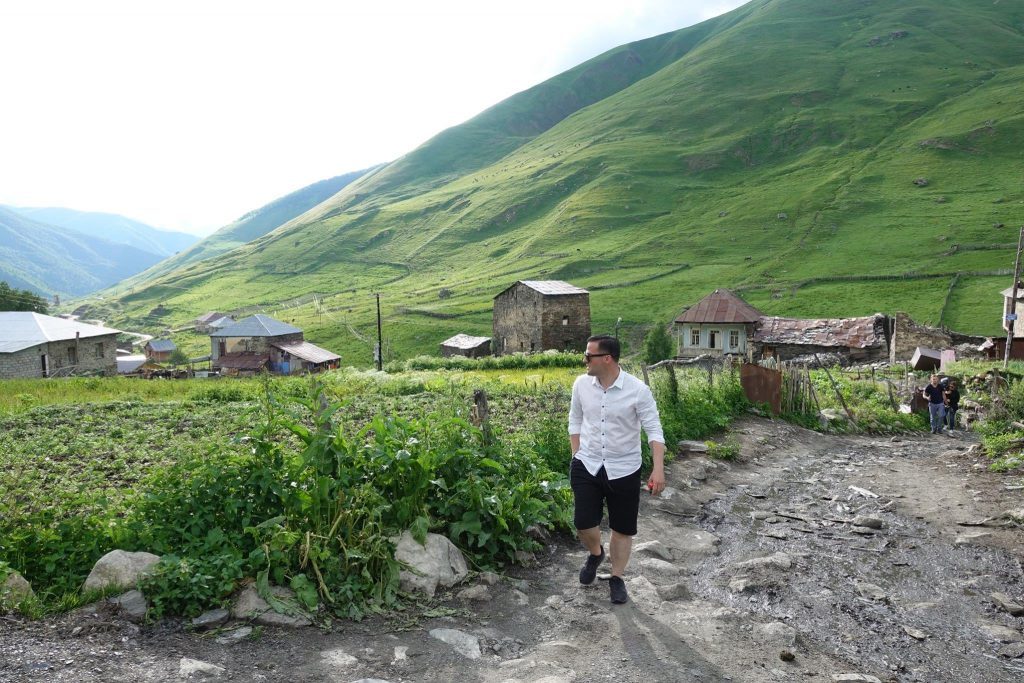
Useful Info
- Accommodation in Ushguli – guesthouse Gamarjoba run by Temraza Nizharadze, more info here http://gamarjoba-ushguli.com/.
- Ethnographic Museum in Ushguli – entry 5 GEL, more info here: https://www.facebook.com/ushgulimuseum/.
- For the more curious – Facebook is home to the open group Svaneti Renaissance (https://www.facebook.com/groups/SvanetiRenaissance/), which posts news about the heritage sites, history and culture of Svaneti, with the intention of promoting and protecting local history. The group language is English, featuring lots of unique news from the region.
Tour Svaneti with us:
- Georgian Wilds 8 days
- Svaneti and Racha, adventure and chacha 10 days
- Georgia and Svaneti 12 days








AWESOME…